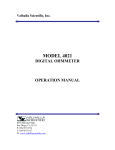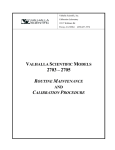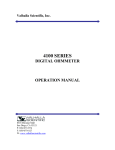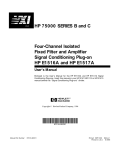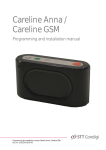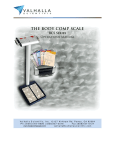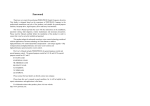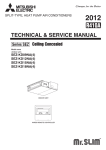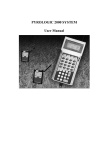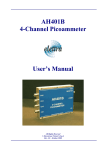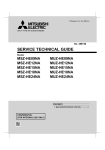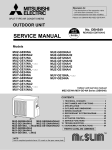Download Model Alpha 4314 - Valhalla Scientific, Inc
Transcript
Valhalla Scientific, Inc. ALPHA 4314 DIGITAL IGNITER TESTERS OPERATION MANUAL 8318 Miramar Mall San Diego, CA 92121 P: 858/457-5576 F: 858/457-0127 W: www.valhallascientific.com VALHALLA SCIENTIFIC INC. CERTIFICATION Valhalla Scientific, Inc. certifies that this instrument was thoroughly tested and inspected and found to meet published specifications when shipped from the factory. Valhalla Scientific, Inc. further certifies that its calibration measurements are traceable to the Nation Institute of Standards and Technology to the extent allowed by NIST’s calibration facility. Due to continuing product refinement and due to possible parts manufacturer changes, Valhalla Scientific, Inc. reserves the rights to change any or all specifications without notice. VALHALLA SCIENTIFIC INC. WARRANTY STATEMENT The warranty period for this instrument is stated on your invoice and packing list. Please refer to these to determine appropriate warranty dates. We will repair the instrument during the warranty period provided it is returned to Valhalla Scientific, Inc. freight prepaid. No other warranty is expressed or implied. Valhalla Scientific, Inc. is not liable for consequential damages. Permission and a Return Material Authorization number (RMA) must be obtained directly from the factory for warranty repairs. No liability will be accepted if returned without such permission. Due to continuing product refinement and due to possible parts manufacturer change, Valhalla Scientific reserves the right to change any or all specifications without notice. ALPHA 4314 Digital Igniter Tester User Manual Edition 1 Copyright © 2003 Valhalla Scientific, Inc. All rights reserved 2 Documentation History All Editions and Updates of this manual and their creation date are listed below. The first Edition of the manual is 1. The Edition Number increments by 1 whenever the manual is revised. Updates, which are issued between Editions, contain replacement pages to correct or add additional information to the current Edition of the manual. Whenever a new Edition is created, it will contain all of the Update information for the previous Edition. Each new Edition or Update also includes a revised copy of this documentation history page. Edition 1 …………………………………………………………………………………….March, 2003 Rev. A …………………………………………………………………………...…….August, 2003 Safety Symbols Instruction manual symbol affixed to product. Indicates that the user must refer to the user manual for specific WARNING or CAUTION information to avoid personal injury or damage to the product Alternating current (AC) WARNING, RISK OF ELECTRICAL SHOCK. Direct current (DC) Indicates the field wiring terminal that must be connected to ground before operation the equipment --protects against electrical shock in case of fault. Frame or chassis ground terminal --- typically connects to the equipment’s metal frame. 3 WARNING Calls attention to a procedure, practice, or condition that could cause bodily injury or death. CAUTION Calls attention to a procedure, practice, or condition that could possibly cause damage to equipment or permanent lost of data. WARNINGS The following general safety precautions must be observed during all phases of operation, service, and repair of this product. Failure to comply with these precautions or with specific warnings elsewhere in this manual violates safety standards of design, manufacture, and intended use of the product. Valhalla Scientific assumes no liability for the customer’s failure to comply with these requirements. Ground the equipment: For Safety class 1 equipment (equipment having a protective earth terminal), an interrupted safety earth ground must be provided from the main power source to the product input wiring terminals or supplied power cable. DO NOT operate the product in an explosive atmosphere or in presence of flammable gases or fumes. For continued protection, replace the line fuse(s) only with fuse(s) of the same voltage and current rating and type. DO NOT use repaired fuses or short-circuited fuse holders. Keep away from live circuits: Operating personnel must not remove equipment covers or shields. Procedures involving the removal of covers or shields are for use service trained personnel only. Under certain conditions, dangerous voltage may exist even with the equipment switched off. To avoid dangerous electrical shock, DO NOT perform procedures involving cover or shield removal unless you are qualified to do so. DO NOT operate damaged equipment: Whenever it is possible that the safety protection features built into this product have been impaired, either through physical damage, excessive moisture, or any reason, REMOVE POWER and do not use the product until safe operation can be verified by service-trained personnel. If necessary, return the product to Valhalla Scientific for service and repair to ensure that safety features are maintained. DO NOT service or adjust alone: Do not attempt internal service or adjustment unless another person, capable of rendering first aid and resuscitation, is present. DO NOT substitute parts or modify equipment: Because of the danger of introducing additional hazards, do not install substitute parts or perform any unauthorized modification to the product. Return the product to Valhalla Scientific for service and repair to ensure that safety features are maintained. Measuring high voltage is always hazardous: ALL multimeters input terminals (both front and rear) must be considered hazardous whenever inputs greater than 42V (dc or peak) are connected to ANY input terminal. Permanent wiring of hazardous voltage or sources capable of delivering grater than 150VA should be labeled, fused, or in some other way protected against accidental bridging or equipment failure. DO NOT leave measurement terminals energized when not in use. 4 Contents Safety Symbols WARNINGS 3 4 Chapter 1 General Information Introduction Manual Description Instrument Description Safety Considerations Instrument Identification 6 6 7 7 7 Chapter 2 Unpacking and Installing Inspection 8 Power Requirements 8 Installation 8 Chapter 3 Specifications Range / Resolution / Test Current / Failsafe Current Accuracy Temperature General Specifications Physical Specifications Chapter 4 Optional Equipment Available Options Test Leads Interface 9 9 9 10 10 11 11 12 Chapter 5 Operations General Front Panel Rear Panel 4-Wire Resistance Measurements Connections Interpreting the Display Failsafe Operations Battery Monitoring Circuitry Range Indicator LEDs 13 13 13 14 15 15 15 16 16 Chapter 6 Theory of Operation General Troubleshooting 17 17 5 Circuit Descriptions Power Supplies Constant Current Source Transconductance Amplifier Failsafe Design Analog to Digital Converter LED Display Range LEDs 18 18 19 20 20 20 21 21 Chapter 7 Routine Maintenance General Required Test Equipment Calibration Procedure Battery Replacement Instructions 22 22 23 24 Chapter 8 Interface Operations BCD Output 25 Chapter 9 Addendums Addendums 26 Chapter 10 Parts List Main Board Assembly Display Board Assembly Chassis & Final Assembly Option BCD Assembly 28 30 31 32 Chapter 11 Schematics & Drawings 33 Alpha4314-070 1 of 5 i Alpha4314-070 2 of 5 ii Alpha4314-070 3 of 5 iii Alpha4314-070 4 of 5 iv Alpha4314-070 5 of 5 v Alpha4314-071 1 of 2 vi Alpha4314-071 2 of 2 vii 2053-76 viii Alpha4314-080 1 of 1 ix Alpha4314-700 1 of 1 x Alpha4314-701 1 of 1 xi Chapter 1 General Information Introduction This manual has information to perform Inspection, Installation, Measurement Operations, and Troubleshooting for Valhalla Scientific Model Alpha 4314. Also included in this manual are: Specifications, Parts Lists and all Schematics. Manual Description This manual is separated into the 11 following Chapters. Chapter 1 – General Information Chapter 1 contains a brief description of the instrument and other general information. Chapter 2 – Unpacking and Installing Chapter 2 contains information for unpacking and inspection the equipment. Also contains power requirements and installation procedure. Chapter 3 - Specifications Chapter 3 contains all specifications, including Range, Resolution, Test Current, Failsafe Current, Accuracy, General and Physical Specifications for Valhalla Model Alpha 4314. Chapter 4 – Optional Equipment Chapter 4 contains information on all available options and test leads for the Valhalla Model Alpha 4314. Chapter 5 – Operations Chapter 5 describes all operations including a description of the front and rear panel, Measurements, Connections, Failsafe, and Battery Monitoring. Chapter 6 – Theory of Operation Chapter 6 describes the theory of operation of all circuits and sub circuits used on Valhalla Model Alpha 4314. Chapter 7 – Routine Maintenance Chapter 7 contains maintenance information, calibration procedure, and Battery replacement instructions. Chapter 8 – Interface Operation Chapter 8 contains information on the optional BCD Output. Chapter 9 – Addendums Chapter 9 lists updates and addendums for this manual. Chapter 10 – Parts List Chapter 10 contains all parts used in the Main Board, Display Board, and Chassis of the Valhalla Model Alpha 4314. The parts are listed with a Reference Designator, Valhalla Part Number, Description, and Manufacturers Part Number. Chapter 11 – Schematics & Drawings Chapter 11 contains all schematics and drawings for Valhalla Model Alpha 4314. 6 Instrument Description The Valhalla Scientific Model Alpha 4314 Digital Igniter Tester is designed to provide extremely safe and reliable resistance testing of explosive or volatile devices. Some of the proven uses include: fuses, squibs, igniters, explosive bolts, automobile airbag initiators and many others. Essentially, a Model Alpha 4314 is a 4-wire ohmmeter which has been designed to use very low test currents for its measurement. Additional circuitry proprietary to Valhalla Scientific is used to ensure that test current levels do not exceed the specified "failsafe current" even in a worstcase component failure situation. The failsafe feature is tested in every instrument before shipment and the results provided to the customer on a Certificate of Calibration that accompanies the unit. The Alpha 4314 series consists of more then 35 different versions spanning the measurement range from 1mΩ resolution to 100MΩ full scale. The Alpha 4314 may have a maximum of four (4) of eight (8) ranges installed at any one time. Unless otherwise specified when placing the order, the Model Alpha 4314 with the 20Ω, 200Ω, 2kΩ and 20kΩ Ranges is the standard configuration. Instruments with special feature are also available. Please check Chapter 8 of this manual for any addendums that may apply to special Alpha 4314 versions. Standard feature of the Alpha 4314 is a battery monitoring circuit that alerts the user if the batteries have become or will soon become unusable. Please refer to Chapter 5 for more details. Front panel LED indicators provide a visual indication of which range are installed and which range is selected. Also refer to Chapter 5 for details. Safety Considerations The Alpha 4314 Digital Igniter Tester is a battery operated equipment, for an optimal function of the Failsafe circuitry DO NOT connect the battery charger while the instrument is in an ON position. Always disconnect the battery charger before operating the instrument. Instrument Identification Valhalla Scientific instruments are identified by a two part serial number. The Serial Tag is located on the rear or bottom of the instrument. The number is in a form of 00-0000. The first two digits, called the serial number prefix, indicate the model. It changes only when a change is made to the instrument. The last 4 digits, called the serial number suffix, are unique for each individual unit. Be sure to include the entire serial number, both prefix and suffix, in any correspondence about your instrument. The serial number can also be found on the Main Board, Calibration Tag and Certificate of Calibration. 7 Chapter 2 Unpacking and Installing Inspection If the shipping carton is damaged, request that the carrier's agent be present when the unit is unpacked. If the instrument appears damaged, the carrier's agent should authorize repairs before the unit is returned to the factory. Even if the instrument appears undamaged, it may have suffered internal damage in transit that may not be evident until the unit is operated or tested to verify conformance with its specifications. If the unit fails to operate or fails to meet the performance specifications of Chapter 3, notify the carrier's agent and the nearest Valhalla Sales Office. Retain the shipping carton for the carrier's inspection. DO NOT return equipment to Valhalla Scientific or any of its sales offices prior to obtaining authorization to do so. Power Requirements The Model Alpha 4314 is powered by an internal rechargeable heavy-duty nickel-cadmium battery pack. The battery charge is maintained by an external AC/DC converter that plugs into a standard 115VAC receptacle. The AC adapter provides 6VDC @ 300mA. For safety reasons, the Alpha 4314 may not be powered directly from the AC adapter. The Alpha 4314 must be turned off and have the adapter connected in order to charge the batteries. The battery pack may power the Alpha 4314 for up to 10 hours before requiring a recharge. Although the batteries are fully charged prior to shipment, it may be desirable to refresh the charge for 24 hours before use. As a rule of thumb, the Alpha 4314 requires twice as much time to fully recharge as the amount of discharge time. For example, if the instrument was used continuously for 2 hours, the AC adapter must be connected for 4 hours in order to fully restore the charge. Installation The Model Alpha 4314 consumes little power and generates virtually no heat. Consequently, it may be used in any area where the environment does not exceed the temperature specifications of Chapter 3 page 10. A rack mount adapter is available to allow installation of the Alpha 4314 in a standard 19" equipment rack. This option is designated as Option R4. When installing this instrument in a rack environment, avoid exposing the Alpha 4314 to extremes of temperature which will affect accuracy and shorten battery life-span. For installation instructions, please refer to the drawing included with the option. 8 Chapter 3 Specifications Range/Resolution/Test Current/Failsafe Current Table 1 RANGE 20Ω 200Ω 2kΩ 20kΩ 200kΩ 2MΩ 20MΩ 100MΩ RESOLUTION 1mΩ 10mΩ 100mΩ 1Ω 10Ω 100Ω 1kΩ 10kΩ 10mA 1mA 100µA 10µA 1µA 100nA 10nA 1nA 16mA 1.8mA 180µA 18µA 1.8µA 180nA 18nA 1.8nA TEST CURRENT FAILSAFE CURRENT[1] [1] Typical value. Actual Failsafe Currents vary from instrument to instrument, and may be ±20% from the value. The actual measured level is provided on the certificate of calibration. Accuracy Table 2 RANGE 20Ω 200Ω 2kΩ 20kΩ 200kΩ 2MΩ 20MΩ 200MΩ ACCURACY ± 0.03% of rdg ± 0.02% of rng ± 0.03% of rdg ± 0.02% of rng ± 0.03% of rdg ± 0.02% of rng ± 0.03% of rdg ± 0.02% of rng ± 0.05% of rdg ± 0.05% of rng ± 1% of rdg ± 0.2% of rng ± 2% of rdg ± 0.2% of rng ± 3% of rdg ± 1% of rng Temperature Temperature Coefficient: ±0.002% per °C (from 0°C-15°C and 35°C-50°C) not applicable for 200kΩ range and above. Operating Temperature Range: 0°C to 50°C Storage Temperature Range: -10°C to 70°C 9 General Specifications Display Type: 4 ½ digits Light Emitting Diodes (LED) (19999) Overload Indication: Display flashes Conversion Rate: 3 readings per second Terminal Configuration: 4-Wire Kelvin Current Source Compliance Voltage: Clamped at 1.6V Power: (4 “D” Cell) 1.2V rechargeable NiCad Batteries 4000mAh Battery Charger: Provides 6VDC at 300mA nominal Physical Specifications Width: 9.5” / 24cm Depth: 11” / 27cm Height: 3” / 8cm Weight: 3 lbs / 1.3kg net; 6lbs / 3kg shipping [1] [1] Shipping weight may vary. 10 Chapter 4 Optional Equipment Available Options Listed below are the options available for use with the Alpha 4314 Series Digital Igniter Testers. Option A: Battery Charger Option "A" is an AC/DC converter that converts 115VAC line voltage to 6VDC at 300mA. One charger is provided as a standard accessory with every Alpha 4314. Replacement Batteries The rechargeable NiCad batteries installed in the Alpha 4314 should provide years of trouble-free operation. Replacement, however, will eventually be necessary. The Alpha 4314 uses four 1.2V cells installed in a reusable battery box. The batteries are held in place by reusable tie-wraps. When ordering replacement batteries, please specify Valhalla Stock #05-10117, quantity four (4). Option CC4: Carrying Case Option "CC4" is a meter and accessory carrying case with extra room for test leads, battery charger, etc. Option R4: Rack Mount Adapter Option "R4" is an adapter tray that allows the Alpha 4314 to be installed in a standard 19" equipment rack. Test Leads Option K: 4-Wire Kelvin Lead Set Option "K" is the recommended general purpose lead set for all Valhalla Ohmmeters. Option K is a shielded 48" lead set terminating in ½ inch gold plated clips. Option MP-S: Single Probe Lead Set Option "MP-S" is a 4-wire lead set terminated in single points. The 4-wire configuration is maintained up to the point of the probe, eliminating most cable resistance effects. Option MP-S may be used where a single probe tip is a must. Option MP-1: Kelvin Micro-Probes Option "MP-1" is a 48" shielded lead set (dual banana), handheld pencil type, terminated in spring loaded steel tips with .05" separation (1 amp max.). Special orders or modified versions available upon request. 11 Option MP-2: Kelvin Mini-Probes Option "MP-2" is a 48"shielded lead set, handheld pencil type, terminated in spring loaded steel tips with 0.18" separation. (1 Amp max.) Option MP-3: Kelvin Micro-Probes Option "MP-1" is a 48" shielded lead set (dual banana), handheld pencil type, terminated in spring loaded steel tips with .08" separation (1 amp max.). Special orders or modified versions available upon request. Option MP-4/MP-5: Surface Probes These probes permit rapid, repeatable bonding testing on a variety of screened or flat surfaces. Test current is evenly distributed through the probe base while sensing is accomplished via a spring loaded center contact. The "MP-4" target area is 1" in diameter. The "MP-5" target area is .4" in diameter. Option KK: 4-Wire Kelvin Lead Set Option "KK" is a 48" heavy duty cable set terminated in large "jaws" that have an open span of 2". Option C: Banana-to-Clip Cable Option "C" is a 48" shielded cable terminated in dual alligator clips Option BBL: Banana-to-Banana Cable Option "BBL" is a 48" shielded cable terminated in dual banana plugs at both ends. Option KCS: Kelvin Clips Option "KCS" is the gold plated Kelvin clips used on the Option "K" cable. These clips may be used when making custom cables or when repairing Option "K". Option JAWS: Heavy-Duty Clips 2" opening for use on large bushings, transformers and motors. The upper/lower jaw teeth (gold plated) provide true 4-wire measurement. Can accommodate up to 150 amps. Interface Option BCD: Data Output This option provides parallel BCD data on p rear-panel 50-pin connector. All outputs are TTL comparable levels with a drive capability of 1 LS load. The Option BCD may be used to drive the Valhalla Model 1248. (See Chapter 8) Model 1248: Dual-Limit Comparator The Valhalla Model 1248 may be used in conjunction with an Alpha 4314 and Option BCD above. The Model 1248 is a dual-limit BCD comparator that interprets the display indications of the ohmmeter as either "HI", "LO" or "GO", based on a tolerance that is set by the user. Relay contact closure is provided to trigger an alarm, counter, batch sorter or other device. The 1248 also reduces operator workload by allowing him to make an instant determination of the test results. The mating cable from the ohmmeter to the 1248 is 3' in length and designated as "IDC-2". 12 Chapter 5 Operations General This section of the manual contains complete operating instructions for the Alpha 4314 Series Digital Igniter Testers. A description of the front panel controls, connection instructions, and the theory behind 4-wire resistance measurement is discussed in this section. Front Panel Power Switch When the front panel power switch is placed in the OFF/CHARGE position, all power is removed from the output terminals, and the battery pack is connected to the charging circuit. When the switch is placed in the ON position, the battery pack is disconnected from the charging circuit. The possibility of a common mode voltage between the device under test and AC Power ground is therefore eliminated. Range Switch The Model Alpha 4314 input range is selected by depressing the desired button on a multistation interlocking pushbutton array located on the right-hand side of the front panel. The pushbutton for the lowest resistance range is nearest to the POWER switch. LED indicators will point out the range and failsafe current selected. Rear Panel Fuse holder The fuse holder is mounted on the rear panel and contains a 2 amp in-line fuse. This fuse is designed to protect the battery pack from excessive charging currents. Customers may request special models with the fuse holder mounted on the front panel. For continued protection, replace the line fuse only with fuse of the same voltage and current rating and type. DO NOT use repaired fuses or short-circuited fuse holders. Charging Jack The battery charging jack is a barrel type and is located on the Alpha 4314 rear panel. The center pin of the connector is positive. The charging requirements of the internal battery pack are 6VDC @300mA. The correct charging voltage is supplied by the adapter included with the instrument. Additional adapters are available as Option "A". Customers may request special models with the charger jack mounted on the front panel. 13 4-Wire Resistance Measurement The four-terminal configuration of the Alpha 4314 eliminates errors normally caused by test lead and contact resistances. In many applications the contact resistance can exceed the value of the load by several orders of magnitude. The Alpha 4314 bypasses this potential error source by providing two terminals of constant current and an additional two terminals for high impedance voltage measurement. The result is a fast, accurate resistance measurement of the load, independent of the resistance of the current carrying leads. Figure 1 Error Sources in Resistance Measurements Figure 1 illustrates how the 4-wire principle is used to eliminate lead, wire and contact resistances as potential error sources. The internal current source inherently overcomes all series resistance (within compliance voltage limits) and delivers a precise constant current. The internal high-impedance DVM senses the voltage drop across the load. There is negligible contact and lead resistance error created by the voltage measurement because the high input impedance of the DVM limits current flow in the voltage leads. 14 Connections Connections are made to the front panel terminals using a 4-wire configuration as described in 4Wire Resistance Measurement. When using Valhalla test leads, the tabbed side of the banana jack is plugged into the current terminals. This ensures that the current is carried in the largest conductor and that the voltage input is shielded. VHI ☼ ☼ IHI ←Tab VLO ☼ ☼ ILO ←Tab Interpreting the Display All Valhalla ohmmeters use a high impedance voltmeter as part of the resistance measurement process. This voltmeter is a highly accurate and stable 4 ½ digit analog-to-digital converter (A to D). Unless it is receiving a definite input signal, the output reading of this A to D is ambiguous. The display may indicate a randomly wandering number or it may indicate an overrange condition. This unpredictable display may make it seem to appear that the instrument is experiencing some sort of malfunction. It is, in fact, just a characteristic of the voltmeter circuit and should not be mistaken for a fault in the instrument. The display indications should be ignored unless there is a definite measurement being taken. If this wandering display is not acceptable, the ohmmeter can be made to indicate an overrange condition whenever the terminals are open by using a 4-wire Kelvin type lead set or by shorting the VHI and IHI terminals together. The display should indicate a stable reading when the test leads are securely attached to the device under test. If the display appears to be erroneous when connected to a load, recheck the test leads for integrity and cleanliness. If all external items appear to be functioning properly, the problem may be the ohmmeter. In this case, please contact your local Valhalla Scientific Sales Office. Failsafe Operation The Alpha 4314 Series Igniter Testers incorporate a proprietary current source design that renders them incapable of delivering excessive voltage or current to the device under test. The typical failsafe current for each range is indicated under the corresponding range LED marker on the Alpha 4314 front panel. Please refer to Failsafe Design in Chapter 6 for a technical description of the failsafe circuitry. Every Alpha 4314 Series Igniter Tester is thoroughly tested before it leaves the factory. These tests include a failsafe test that simulates a "worst case" failure condition. The resulting output 15 current is recorded and provided on the Certificate of Calibration included with every Alpha 4314. As a further precaution the Alpha 4314 is isolated from the AC line whenever the POWER switch is in the ON position. The Alpha 4314 receives its power from an internal rechargeable battery pack. The Alpha 4314 must be in the OFF/CHARGING position in order to charge the batteries. Battery Monitoring Circuitry A standard feature of Alpha 4314 is a circuit that monitors the output voltage of the internal battery supply. The indicator for this feature is located to the far left of the display window and is a red light bar " - ". If this LED flashes during a measurement, this indicates that the batteries will require recharging within the next 2 hours of continuous use. Readings are still within specified accuracies at this point. If the LED is continuously illuminated, readings should not be trusted. An overnight recharge should be performed before using the Alpha 4314 for critical testing. e It is possible for the user to receive a low battery indication on a single range only (particularly the 20Ω range), while the Alpha 4314 remains well within operating limits on other ranges. Unless the user observes a continuous low battery indication during measurement, readings are still valid. Range Indicator LEDs The Alpha 4314 can have 4 of 8 possible ranges. The ranges installed are indicated on the front panel by a series of lit LEDs. The range that is selected during measurement is indicated by a RED LED. 16 Chapter 6 Theory of Operations General The Valhalla Scientific Model Alpha 4314 Digital Igniter Tester is shown in block diagram form in Figure 2. All information disclosed in this section is proprietary and is included in order to make troubleshooting to component level possible. The Model Alpha 4314 uses solid-state semiconductors exclusively and CMOS circuits extensively to minimize power requirements and make battery operation practical. Figure 2 Model Alpha 4314 Block Diagram Troubleshooting Malfunctions are often the result of misinterpretation of specifications or due to an incomplete understanding of the instrument. A thorough review of the operating instructions for this instrument is recommended prior to any component replacement. Check to be sure that cables and other test equipment are in good working order before attempting to troubleshoot the Alpha 4314. If the Model Alpha 4314 exhibits problems that cannot be eliminated by reviewing Chapter 3 and 5, the following guidelines have been established to help solve the problem. 17 Localizing the Problem: The key to successful troubleshooting is to localize the problem as much as possible before trying to pin the problem down to a specific component. Certain questions should be asked such as "Does the problem occur on all ranges or on a specific range only?” The power supplies are also one of the first things that should be checked. As it is not possible to anticipate all failure modes of the Alpha 4314, servicing personnel should become familiar with this section to gain a complete understanding of the internal workings of the Model Alpha 4314. Component Replacement If the problem has been identified as a faulty component, the accuracy of the Alpha 4314 can be maintained only if the following precautions are taken: a) Use only the specified component or its exact equivalent. Spare parts can be ordered from your nearest Valhalla Scientific Service Center or directly from the factory by referring to the Valhalla Stock Number listed in the Parts Lists section at the back of this manual. b) Use only 63/37 grade rosin core electronic grade solder with a 50W or lower maximum power soldering iron. c) When soldering, heat the terminal of the component, not the solder. Apply solder smoothly and evenly. Do not move the component until the solder has cooled. Bad solder joints can cause additional problems! d) Static sensitive parts require special handling procedures. Always treat an unknown part as if it were static sensitive. Circuit Description The circuit descriptions which follow are referenced to Figures 2, 3, 4 and the schematic diagrams in Chapter 10. In the following descriptions, references to integrated circuits are given in the form "IC2-1", which refers to Integrated Circuit 2, pin 1. Power Supply The Model Alpha 4314 is powered by a rechargeable internal battery pack and cannot be operated directly from the battery charging adapter. This is to prevent the possibility of a short to the AC line. When the POWER switch is in the OFF/CHARGING position, the batteries are connected to the rear panel charging jack to allow for recharge. When the POWER switch is in the ON position, the batteries are disconnected from the battery charger and connected to the internal circuits of the Alpha 4314. 18 The +10 and -10 volt supply is developed by a DC/DC converter composed of Q1, Q2, T1, D2, D3, D4, D5 and their associated components. The +5 volt supply is provided directly by the batteries or regulated from the +10V supply by IC2. The -5 volt supply is regulated from the -10 volt supply by IC1. Constant Current Source The constant current source is composed of IC3, IC4, Q4, D10 and their associated components. The input to the constant current source is approximately +1.05 volts, developed at IC3-7 and connected to IC3-13 through R12 and R13. The heart of the constant current source is the voltage-to-current converter, which incorporates a Transconductance Amplifier. A simplified schematic of this unique circuit is shown in Figure 3 and described in the next section. The amplifier of IC3-12 is an inverter, and its output is applied to IC3-9. The amplifier of IC3-8 has unity gain due to the feedback through R18. Its output is applied to the inverting input of IC4-3. The output of IC4-6 provides feedback to the non-inverting input of IC3-10. This circuit operates to maintain the inverting input at IC4-3 and the non-inverting input at IC4-2 at the same potential. Figure 3 Transconductance Amplifier 19 Transconductance Amplifier (U.S. Patent No. 4,091,333) Assume that terminals Ihi and Ilo of Figure 3 are shorted, and 1 volt is applied to Ein so that Ihi is positive. To equalize the inputs of IC4, IC3 must be driven to zero. This condition occurs only when the voltage drops across R17 and R19 are equal to the drops across R18 and R20. For these voltage drops to be equal, the output of IC4 must be at +1 volt. Since the output of IC3-8 must be zero, the drop across R18 is 0.5 volts, making the inverting input 0.5 volts. The drops across R17, R20 and R19 will also be 0.5 volts. Since the inputs to IC3 are essentially equal, its output is zero (offset by the few µV required to drive IC4 to +1 volt). Under these conditions the sum of the voltages across R17, R18, R19 and R20 equals the sum of Ein plus the output of IC4. Consider now that the short is removed from the Ihi and Ilo terminals and a 100-ohm resistor (RL) is connected in its place. The current through RL increases the voltage at the input to IC3. A balanced condition will be reached when the output of IC3 is equal to the non-inverting input of IC4. Again, this condition occurs when the voltage drops across R17 and R19 are equal to the voltage drops across R18 and R20. At this time the output of IC4 is 1.1 volts. The voltage drop across the Range Resistor is 1 volt, just as it was when the output terminals were shorted. The current through RL is 10mA, just as it was through the jumper when the output terminals were shorted. Failsafe Design Reference to the Model Alpha 4314 schematic will show that the output of IC4-6 is actually applied to the base of transistor Q4, which acts as a current limiter. The worst-case failure that could occur in this circuit would be a Q4 short, which would effectively connect the -5 volt supply directly across R44, D9, the range resistor and RL. D10, however, acts as a 1.6 volt zener diode, limiting the voltage that can appear across these components. Even if every component in the amplifier circuit shorted, the current through the igniter could not exceed safe limits, because the -5 volt supply includes inherent limiting. Because of the design of T1, the -5 volt supply can only deliver 20mA to 25mA before the DC/DC converter disengages, dropping the -5 volt output to zero. Analog to Digital Converter The Analog to Digital conversion in the Model Alpha 4314 is aloud by IC 7 and its associated components. The reference voltage applied to IC7-2 is 1Volts. 1.2Volts are generated buy D16 and adjusted by R40 before being applied to IC7-1. Due to this reference, the voltage across the load is amplified X10 by IC6 and its associated components. IC8 generates a 120 kHz clock signal for IC7-22; the frequency of the oscillator allows the Alpha 4314 a conversion rate of 3 readings per second. The digital portion of IC7 is applied to IC9 a BCD to 7 Segment Converter/Driver and to the driver transistors Q5-Q9. 20 LED Display The signal converted by IC9 is applied to four 7 Segment LEDs (DS2-DS5) and a ±1 LED (DS1). Concurrently, driver transistors Q5 through Q9 are turned on in sequence. This sequence is repeated at the 120 kHz rate, and the data display consequently appears to be continuous. Low battery status is indicated by the “–” minus sign of DS1. The battery monitoring circuitry is calibrated so that if the battery level falls to 4.7Volts, IC5-2 will be at 1Volt. IC5-3 is connected to the 1Volt reference. IC5-6 will be high if the battery level falls below 4.7V and therefore if IC5-3 is grater than IC5-2. IC5-6 is applied to DS1-7, the “–” sign of DS1 will be ON when IC56 is high. Range LEDs The 4 Range LED indicators are positioned on the display board and connected to the range switches according to the range selection. The LEDs are dual-color, and will display red if the range is not activated or green if the range is activated. See schematics ALPHA4314-071 for details. Figure 4 LED Display Pin Function 21 Chapter 7 Routine Maintenance General This section of the manual contains routine maintenance information regarding the Valhalla Scientific Model Alpha 4314 Digital Igniter Testers. Calibration should be performed on a regular basis to ensure continued instrument accuracy. The recommended calibration interval is 1 year. Required Test Equipment Following is a list of the standard resistors and other equipment required to calibrate the Model Alpha 4314. Note: The Precision Resistors necessary for the calibration of the Alpha 4314 varies based on the installed ranges. Precision Resistors: .1Ω ± 0.01% Accuracy 10Ω ± 0.005% Accuracy 100Ω ± 0.005% Accuracy 1KΩ ± 0.005% Accuracy 10KΩ ± 0.005% Accuracy 100KΩ ± 0.005% Accuracy 1MΩ ± 0.005% Accuracy 10MΩ ± 0.005% Accuracy 100MΩ ± 0.005% Accuracy 20Ω Range 200Ω Range 2kΩ Range 20kΩ Range 200kΩ Range 2MΩ Range 20MΩ Range 100MΩ Range Test Leads: 4-Wire Lead Set (Valhalla Option "K" or "C") Voltage Standard: Voltage Calibrator capable of outputting from 0V to negative 100mV, 0.03% Accuracy or better. (Valhalla Model 2701C) Power Supply: Power supply capable of outputting from 4.6 to 6VDC. 22 Calibration Procedure The Alpha 4314 should be calibrated with fully charged batteries and should be allowed to warm-up for a minimum of 15 minutes before beginning the procedure. The adjustments are accessed by removing the four feet screws, then lifting off the top cover only. The locations of the adjustments are shown on drawing number Alpha4314-700 in Chapter 11. Voltmeter Adjustment 1. Select Range 1 on the Alpha 4314. 2. Connect the voltage calibrator to the voltage terminals and use a jumper to short the Voltage Sense Lo and Current Source Lo terminals. 3. Apply -100mV and adjust R40 for a display reading of “10000”. (Decimal point unimportant) 4. Apply -.1mV and adjust R36 for a display reading of “0010”. (Decimal point unimportant) 5. Repeat steps 3 and 4 until both are in specification. Full Scale Adjustment 1. Select Range 2. 2. Connect a standard resistor 1000 times smaller than ½ scale of the range selected. Example: If the 20kΩ range is selected connect to a 100mΩ standard resistor. 3. Adjust R36 for a display reading of “0010” (Decimal point unimportant). 4. Remain on Range 2 and connect to the correspondent ½ scale standard resistor. Example: If 200Ω range is selected, connect to a 100Ω standard resistor. 5. Adjust R15 for a display reading equal to the resistor value. 6. Check all remaining ranges with the appropriate standard resistors. All ranges must be within the specifications outlined in Chapter 3. Low Battery Indicator Adjustment 1. Turn OFF the instrument, remove the fuse and connect an external power supply at 5.4 volts across C1, observing polarity. 2. Turn on the instrument, select Range 1 and connect to the correspondent ½ scale standard resistor. Dial the power supply down to 4.7 volts. The “Low Battery” indicator should come on. If not, adjust R32 until the LED just illuminates. The display must remain stable and must not freeze up. 3. Increase the supply to 4.8 volts and note that the LED goes off. 4. Turn off the instrument, disconnect the power supply and replace the fuse. 23 Checking the Calibration Results ½ Scale and Linearity Check Apply to each range resister values equal to 50% of range, 5% of range, 0.5% of range and 0.05% of range. All values should be within the tolerance specified in Chapter 3. Zero Check 1. Apply a short between VHI and VLO. 2. Apply a short between VLO and ILO. 3. Check the display for 0 ± 3 digits Battery Replacement Instructions The rechargeable NiCad batteries used in the Alpha 4314 are very durable and should provide years of trouble-free operation. As with all batteries, replacement will eventually be necessary. Batteries may be ordered from Valhalla Scientific as stock #05-10117, quantity: (4). The process of battery replacement is described below: 4. 5. 6. 7. 8. Remove the four feet screws and the bottom cover. Undo the reusable tie-wraps by pushing down on the locking pin. Remove the old batteries and replace. Observe polarity! Secure the new batteries in place by re-tightening the tie-wraps. Replace the cover and feet screws, taking care not to pinch any wires. 24 Chapter 8 Interface Operations BCD Interface Option BCD has a rear mounted 50 pin Amphenol connector providing data in a parallel binarycoded-decimal (BCD) format. The outputs are TTL compatible and may drive 1 LS load. The summary of pin functions is provided below and on the schematic number 2053-076 at the back of this manual. Pin Number Data 1 2 3 4 6 7 8 9 11 12 13 14 16 17 18 19 21 22, 40 26 50 1 2 4 8 10 20 40 80 100 200 400 800 1000 2000 4000 8000 10000 20000 (overrange) +5 VDC supply 0 VDC common 35 End of Conversion on negative transition (A high signifies "Busy") 45 Display Hold Line (+5V or open = Run; 0V = Hold) The BCD outputs are fully compatible with the Valhalla Model 1248 BCD Comparator. When connecting to the comparator using the standard IDC-2 interface cable, the end of the cable possessing the wire break-outs is connected to the Model 1248. 25

























